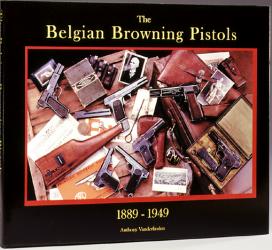 |
The FN Browning Model 1922 Pistol |  |
|
|
|
|
CRUFFLER.COM
presents
HISTORIC
FIREARM OF THE MONTH,
May 2001:
 |
The FN Browning Model 1922 Pistol |  |
|
Type: Self Loading Pistol System of Operation: Blowback Caliber: 7.65mm Browning or 9mm Browning Short Capacity: 8 round box magazine Sights front: Blade Sights, rear: Adjustable aperture Length: 7.01" Weight (loaded): 25.7 ozs Barrel: 4.5", 6 grooves, right hand twist |
HISTORY
The Fabrique
Nationale (FN) Browning Model 1922 pistol bears the distinction of being
developed strictly at the request of a FN customer. Specifically,
the "Kingdom of Serbs, Croats and Slovenes" (later known as Yugoslavia)
which had been created out of the ashes of the Austro-Hungarian Empire.
In the early 1920's the Yugoslav military was in a shambles. Its
constituent entities had fought the Balkan wars of 1912 and 1913, then
the First World War. The arsenals were empty, and the army devoid
of war materiel. The Serbs, forming the majority of the new Yugoslav
state, had been an important FN client since the beginning of the firm,
in the 1880's, and decided to turn to the Belgian firm for their war materiel
needs. Initial considerations for the new Yugoslav service handgun
were the FN Models 1903 and 1910. The Model 1903 was rejected as
being too expensive. The Model 1910 gained favor because of its relatively
economical pricing and 9mm Browning Short cartridge. While the Model
1910 performed well in the evaluations, it had some shortcomings as a military
pistol. The Yugoslavs requested a longer barrel conducive to greater
accuracy, as well as increased magazine capacity.
| The design problem was turned over to the FN Bureau d'Etudes (Research and Development Office). The Bureau d'Etudes took stock of the situation. The Yugoslavs certainly couldn't afford the expense of developing and tooling for a new pistol. Consequently, a series of modifications to the Model 1910 were proposed that would save considerably on tooling and start up production costs. A forged steel cap was added to the 1910 slide in order to accommodate the longer (113mm as opposed to the 1910's 88mm) barrel. The frame was lengthened to accommodate the longer magazine. A lanyard ring was added. The engineering was complete by 1922, and the Yugoslavs placed an order for 60,000 pistols on February 28, 1923. |
Image Credit: Vanderlinden, Anthony, The Belgian Browning Pistols, Wet Dog Publications, Greensboro, North Carolina, 2001: Page 129 |
OPERATION
The M1922
is a blowback operated pistol; there is no mechanical lock between the
slide and barrel. Instead, the breech is held closed by a combination
of the mass of the slide and a stout recoil spring. Operation of
the pistol is as follows: A loaded magazine is inserted into the
butt, and the slide drawn to the rear. When the slide is released,
it moves forward under pressure of the recoil spring and strips a round
from the magazine into the chamber, retaining the cartridge's rim under
the externally mounted extractor. When the slide is drawn to the
rear, the striker is also pulled to the rear, compressing the striker spring.
When the slide is drawn to the rearmost position, the striker's nose rides
over, and is retained by the sear.
Northbrook, Illinois,1992: Page 66 |
When the trigger is pressed, the trigger bar presses against the sear, rotating it back and down. This frees the striker to move forward and fire the chambered round. Upon firing, the case moves sharply rearward, imparting rearward motion to the slide. The case is pulled from the chamber by the extractor. As the slide moves to the rear, the striker's tip is pushed out through the firing pin hole and serves as an ejector. The M1922 is equipped with a triple safety system. There is a grip safety which, unless depressed, prevents the sear from rotating and releasing the striker. There is a thumb safety which, when engaged, prevents the grip safety from being depressed. The thumb safety cannot be engaged unless the grip safety is released. There is also a magazine safety that prevents the sear from rotating unless a magazine is fully seated in the |
Disassembly is effected by first removing the magazine There is a latch on the forward left side of the slide at the junction of the slide and the slide cap. By pressing the latch toward the muzzle, the slide cap is freed to rotate. By rotating the slide cap ninety degrees, the cap's internal tenons are freed from the interrupted raceway internal to the front end of the slide, and the cap can move forward and out of engagement with the slide (note: it is under considerable pressure from the recoil spring). The slide is then easily retracted and the safety locked into the forward, disassembly notch. The barrel is now aligned with the slide's disassembly recess. The barrel can now be rotated ninety degrees counterclockwise (as viewed from the muzzle). This rotates the barrel tenons out of their recesses in the frame. The slide and barrel can then be slid forward off the frame. The recoil spring can be removed, the barrel rotated back, and then pulled out from the front.
CONTRACT PISTOLS
Many nations
adopted the Model 1922, each of them under a separate contract from FN.
The following is a short listing of the Model 1922 contract pistols.
|
Yugoslavia: Yugoslavia was the first nation to adopt the Model 1922, placing an order for some 60,000 pistols in February, 1923. Orders for the pistols continued into the late 1930's, with service being provided for the Yugoslav pistols at the Kragujevac Arsenal (which had been set up under the guidance of FN personnel). Many of the Yugoslav Army M1922 pistols were captured by the Germans during World War Two. These captured pistols were reissued to German and satellite forces under the designation P641(j). Large quantities also remained in partisan hands, becoming known as the primary pistol of Tito's Army. Yugoslav Army pistols are marked in Cyrillic on the right side of the slide with the legends "Army State" or "Officer." |
Publications, Greensboro, North Carolina, 2001: Page 135 |
Publications, Greensboro, North Carolina, 2001: Page 140 |
Holland: The Dutch government placed its first order for Model 1922 pistols in October 1924. The 2,000 7.65mm pistols in this shipment received the Dutch designation Pistool M25 No.1, and was intended for issue to two different law enforcement agencies. The Koninklijke Marechaussee, or Royal Military Constabulary, received approximately 1,200 pistols from this order, while the Politie Troepen, or Police Troops, received the remaining 800. In the following year the Dutch expanded issue of the M1922 to machine gun crews. The M1922's issued to the Dutch Army were known as Pistool M25 No.2, the designation differing as the army guns were chambered for the 9mm Browning Short instead of 7.65mm. Serialization of the M25 No.2 started at 3000, with the first order of 2,000 pistols being shipped in April 1926. Military orders continued |
|
|
|
|
|
|
|
|
|
|
|
|
|
|
|
|
|
|
|
|
|
|
|
|
|
|
|
Additional
Dutch orders were placed for law enforcement agencies. In 1927, 150
M25 No.2 pistols were purchased for the Curacao police. In 1929,
the rural police force purchases 100 M25 No.1, and in 1934, the Dutch National
Bank upgraded 100 M1910 pistols to M1922's.
| Greece: The Greeks purchased 9,980 M1922 pistols chambered for 9mm Browning Short in 1926. This was the official sidearm of the Greek Army and Air Force from 1926 to 1941. The order was delivered between 1926 and 1929. |
Publications, Greensboro, North Carolina, 2001: Page 143 |
Publications, Greensboro, North Carolina, 2001: Page 144 |
Turkey:
Continuing an Ottoman tradition of FN patronage (Ottoman police were armed
with FN Model 1903 pistols), the newly formed Turkish Republic purchased
M1922 pistols for the Turkish Army. Three contract variations have
been noted, although it is possible that more may surface.
Variant 3: Marked "Subaylara Mahsustur" (Property of Officer of the Armed Forces) |
| Romania: The Romanian contract pistols were shipped from FN in September 1935, and were marked with the crest of the Ministry of the Interior, indicating issuance to a law enforcement agency. These pistols were ordered through the FN dealer and distributor in Bucharest, B.D. Zissu. |
Publications, Greensboro, North Carolina, 2001: Page 145 |
Publications, Greensboro, North Carolina, 2001: Page 146 |
French Navy: Ordered in approximately 1932, these 7.65mm pistols are often mistaken for postwar guns. Careful examination notes several pre-war features (17 as opposed to 16 cocking serrations, horn grips, differing slide legends). Ordered with typical French cost saving features such as black enamel finish and unfluted slide cap, the guns were refinished by the French after the war with a green/gray parkerizing over the original remaining finish. |
| Danish Police: Denmark ordered 3,000 7.65mm M1922 pistols for the Danish Federal Police in the 1930's. |
Publications, Greensboro, North Carolina, 2001: Page 149 |
Publications, Greensboro, North Carolina, 2001: Page 156 |
Nazi Occupation Pistols: The M1922 has the dubious distinction of being produced in larger numbers than any other firearm at the FN plant during the Nazi occupation. The German designations for the M1922 were Pistole 626(b) for the 7.65mm version and Pistole 641(b) for the 9mm Short version. M1922's found their way to all corners of the German government and military as officer's and official's sidearms. The primary user of the M1922, however was the Luftwaffe. Interestingly, the M1922 was also offered as a commercial pistol up to 1942, being sold mostly as sidearms for war factory security personnel and police. M1922's accepted by the German military show one of three Army Weapons Office inspectors markings (Waffenamt stampings). |
| Post-Liberation M1922's: With the liberation of Liege in late 1944, what was left of the original factory staff returned and restarted production. The M1922 was one of the first products to come off the lines of the liberated factory. Most of these pistols were for military or government contracts. These pistols were built with at least some parts made during the occupation, and were so noted by having their serial numbers prefixed with the letter "A." Finish on the A-prefix pistols was either a matte bluing or black enamel. These pistols were purchased by the French military and police, the Belgian military, the Dutch military and Department of Finance, and the security personnel of the Netherlands Steamship Corporation. |
Publications, Greensboro, North Carolina, 2001: Page 157 |
Postwar Contracts: After the war, the M1922 found extensive use with West German police agencies and the French government. The M1922 was used by the French Army up to 1957, by French Customs to 1983, by forestry agents until the late 1980's, and by the Parisian police up to at least the 1970's.
CONCLUSION
The M1922
is often overlooked by American collectors for any number of reasons; it
wasn't offered in a "major" caliber, it wasn't an "official" military sidearm
of any of the major combatants in World War Two, it was little more
than an upsized pocket pistol. This lack of interest belies the historical
significance of this pistol. With its older brother, the M1910, the
M1922 was THE European sidearm of the interwar years, and the gun
responsible for the word "Browning" continuing to be synonymous with "automatic
pistol." Moreover, its design, while elegantly simple, was
innovative, reliable, and effective. M1922's can be found on the
US collector market for surprisingly low prices, and in surprisingly good
condition. For the collector of European pistols or, for that matter,
the Cruffler, the M1922 is a piece of history that should not be missed.
BIBLIOGRAPHY
Vanderlinden, Anthony, The Belgian Browning Pistols: 1889 - 1949, (Wet Dog Publications, Greensboro, North Carolina: 2001)
The Belgian
Browning Pistols: 1889 - 1949 is available from Wet Dog Publications.
Click on the image to order:
